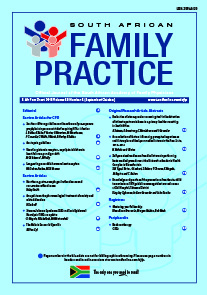Self-perceived readiness of medical interns in performing basic medical procedures at the Universitas Academic Health Complex in Bloemfontein
Keywords:
basic medical procedures, education, medical interns, readiness, skills
Abstract
Background: Medical internship in South Africa is a two-year period after completing the basic medical degree. Interns rotate through six different domains, where they are exposed to various clinical procedures. These skills are often not up to standard, and interns feel unprepared for future challenges. This study evaluated the self-perceived readiness of interns rotating through the Universitas Academic Health Complex in performing basic medical procedures, and the frequency of performing these procedures. Methods: This was a descriptive quantitative study. Consenting participants completed an anonymous questionnaire regarding four pre-selected medical procedures per department. Results: The majority of the 61 participants were second-year interns (52.5%), female (54.0%), with a median age of 25 years. Interns felt ready to perform the majority of procedures, but more than 50% reported not being ready to perform circumcisions, episiotomy and perineal repair, assisted delivery and appendectomies. Some procedures in Family Medicine, Internal Medicine, Obstetrics and Gynaecology, General Surgery and Psychiatry were rarely performed by at least half of the participants. Conclusions: Exposure of medical students during their clinical years to practical training is inadequate. The focus in the MBChB curriculum should be increased to a more specific practical approach during both the pre-clinical and clinical years. (Full text of the research articles are available online at www.medpharm.tandfonline.com/ojfp) S Afr Fam Pract 2016; DOI: 10.1080/20786190.2016.1228560
Section
Original Research
By submitting manuscripts to SAFP, authors of original articles are assigning copyright to the South African Academy of Family Physicians. Copyright of review articles are assigned to the Publisher, Medpharm Publications (Pty) Ltd, unless otherwise specified. Authors may use their own work after publication without written permission, provided they acknowledge the original source. Individuals and academic institutions may freely copy and distribute articles published in SAFP for educational and research purposes without obtaining permission.

